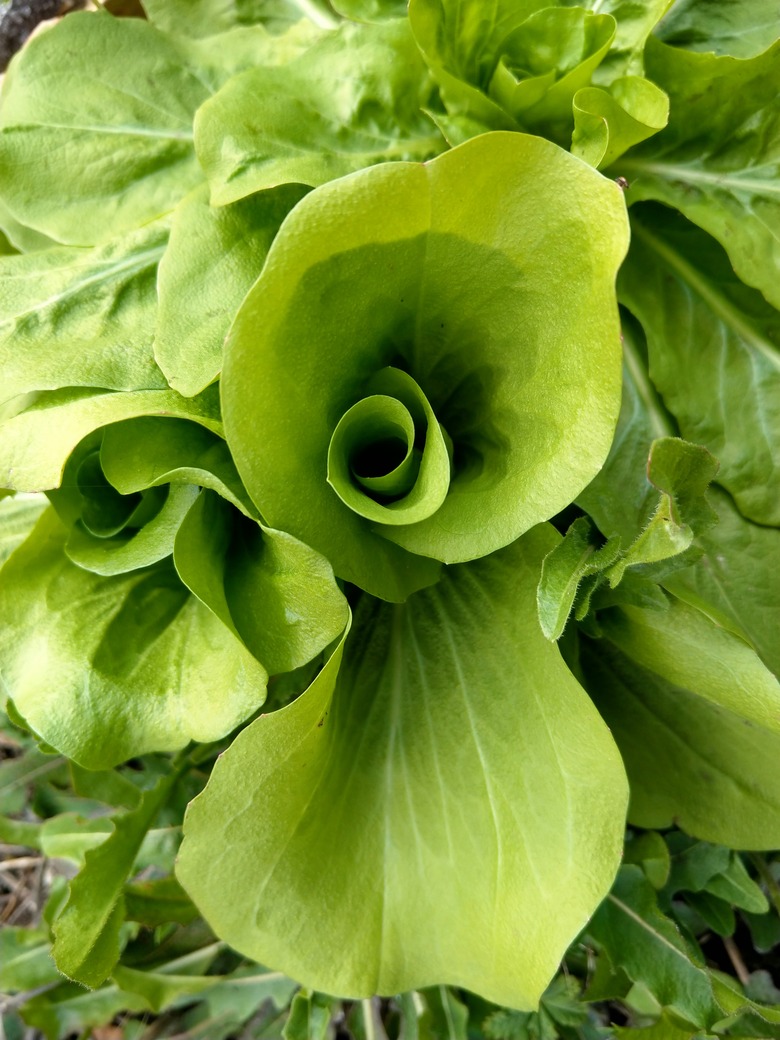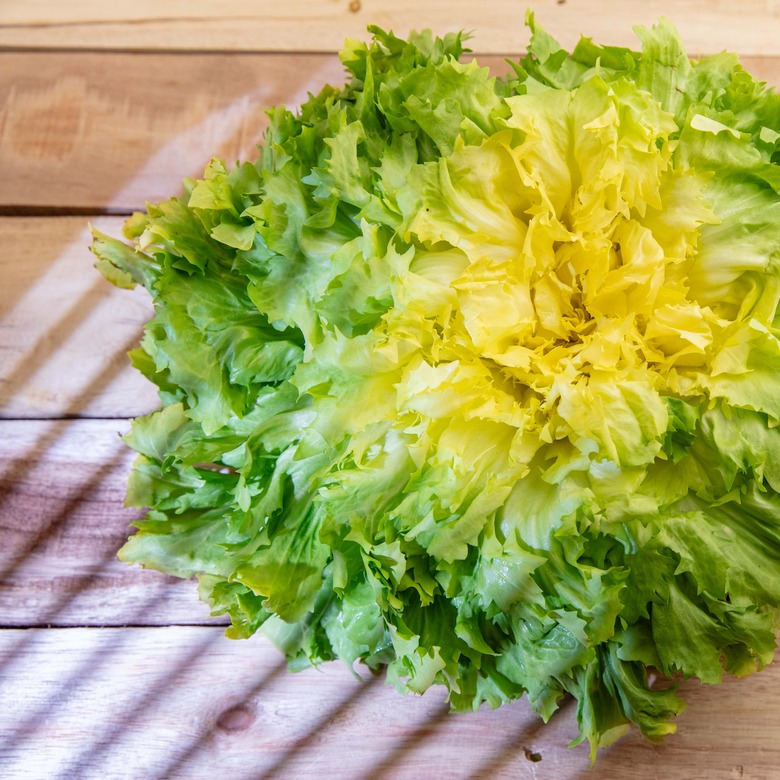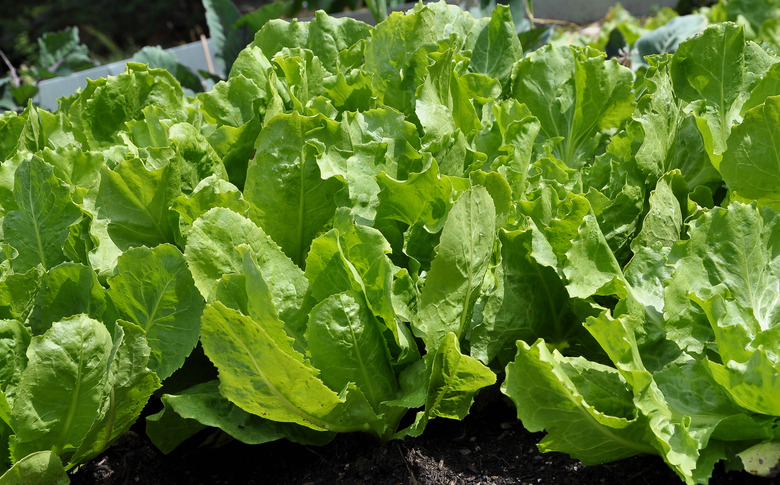How To Grow Escarole
We may receive a commission on purchases made from links.
Escarole (Cichorium endivia var. latifolia) is a leafy annual vegetable that is a close genetic sibling of endive (C. endivia var. crispum). As you might expect from two similar vegetables that carry the same species name, escarole is sometimes confused with endive, and it serves largely the same function in cooking. Escarole is a biennial plant, but it is virtually always grown as an annual, as it is seeded and harvested in its first year of growth. Escarole grows in heads of bunched, upright leaves that are ragged along the edges and curled at the top.
Escarole is sometimes called broad-leaf endive, while its cousin is known as curly endive. Both plants are leafy chicories with a slightly bitter taste, but escarole is slightly less bitter than endive, and it is lighter in color. Escarole is more likely to be used raw in salads, but like endive, it is often added to soups, stews and other dishes as a flavoring herb. It is sometimes used as a wrapping for fish and meat dishes.
Escarole and endive are both cool-season vegetables that are grown in much the same way as — and often alongside — leaf lettuce and other similar leafy vegetables, such as chard and spinach. As with some of those other leafy vegetables, it can be hard to prevent escarole from flowering (bolting) and setting seed if it is planted too early. For this reason, many gardeners like to plant escarole in midsummer for a fall harvest, when the vegetable's taste is said to be at its best. Escarole and endive can be especially hard to grow in the spring in climates where the shift from spring cool to summer heat occurs quickly.
Best Uses for Escarole
Best Uses for Escarole
Escarole is a good choice for gardeners who enjoy mixed salad greens or who frequently prepare recipes that call for fresh escarole or endive. Escarole is especially popular as a chopped ingredient in soups and casseroles. It can be used as a substitute for endive in virtually any recipe.
Escarole is a good vegetable for gardens that have fairly average soil since it does not need much in the way of soil richness. It also works well for those corners of the garden that are partly shady. Escarole typically is planted in rows or patches, and because it is often planted in midsummer for a fall harvest, it can be used to replace early-season vegetables, such as spinach, after they have been harvested. It is often grown alongside radishes, turnips and parsnips.
Escarole can also be grown in raised beds and containers, but the soil will need to be kept consistently moist, and letting the plant dry out will give the leaves a bitter taste. Escarole is a fairly slow-growing plant that can be susceptible to bottom rot in cool, wet weather, so it is sometimes grown in a hoop house or under cover to control moisture.
Escarole is a favorite of organic gardeners. There are several good cultivars of organic seeds available:
- 'Natacha' is one of the best performing of the organic escarole varieties. It is also known as an attractive plant for mixed edible/ornamental gardens.
- 'Eros' is a more compact plant with leaves that are a darker green.
How to Grow Escarole
How to Grow Escarole
How to Start Escarole From Seed
The secret to successfully growing escarole is to time the planting so the leafy heads will mature before the first killing frost occurs in the fall. Although escarole can be planted in the spring, the fast-changing weather at this time of year can make it tricky to grow since the plants may shoot up flower stems (bolt) before you can get a decent harvest. For this reason, escarole is often planted in midsummer and then harvested in the fall.
- Space the seeds 1 to 2 inches apart and cover them with 1/4 inch of soil.
- As seedlings sprout (nine to 14 days after planting), thin them out to about 12 inches apart.
- Keep the soil constantly moist until the seeds have germinated and sprouted into sturdy seedlings.
- If you do try to plant escarole early in the spring for a summer harvest, you should sow the seeds about four weeks after the last frost, or you can start the seeds indoors in trays about six weeks before outdoor planting time.
How to Start Escarole From a Seedling
Purchased nursery seedlings typically take about eight weeks to mature into harvestable heads. Plant the seedlings about 12 inches apart. Some gardeners like to stagger plantings every two weeks to ensure continued harvest into the fall, but this will depend on how long escarole seedlings remain available at your garden center. It's also possible to use nursery seedlings for the first planting and then sow seeds for subsequent plantings.
In What Zone Does Escarole Grow Best?
In What Zone Does Escarole Grow Best?
Escarole and endive are biennial plants that can be grown in just about any hardiness zone — 2 to 11 — as annuals, but these vegetables grow best in moderate temperatures. Hot temperatures usually cause the plants to bolt by sending up flower heads to set seeds, and at this point, the leaves become so bitter that they aren't edible. Gardeners in hot climates (zone 8 and warmer) who want to grow escarole will need to grow it in the cooler seasons of the year.
When Should You Plant Escarole?
When Should You Plant Escarole?
Timing the planting of escarole can be tricky since the seeds need fairly warm soil to germinate, but the plant needs fairly cool weather for best growth. Further, correct timing can reduce the likelihood that the plant will bolt by sending up flower shoots. If you plant at the wrong time, early bolting may ruin your entire crop of escarole. Thus, escarole can take some experimentation before you get the timing right for your region.
Most commonly, escarole is planted in midsummer for fall harvest. This timing works well for most regions, but extreme climates may adopt different strategies:
- In very cool climates, seeds are sometimes started indoors well before the ground is fully thawed and then the sprouted seedlings are planted outdoors about four weeks after the last frost.
- In very warm climates without winter frost, escarole is sometimes planted in the fall for a winter harvest.
- Regions with very long growing seasons may attempt two rounds of planting — one in the early spring for an early-summer harvest, and one in late summer for a fall harvest. The optimum growing temperature is 45 to 75 degrees Fahrenheit, so in regions with hot midsummers, it is usually best to time the planting for an earlier or later harvest.
Spring planting can be problematic because the quickly lengthening days of late spring can cause escarole plants to bolt early. Plants often respond to lengthening days by sending up flower shoots in order to set seeds, and as the plant's energy goes into flower and seed production, it is diverted away from leaf development. This will quickly make the leaves bitter to the taste.
One goal of growing leafy vegetables such as escarole, lettuce and spinach is to prevent them from bolting if possible. For this reason, escarole is often limited to a midsummer planting so it matures for harvest in the fall. Changes in daylight are less dramatic at this time of year, which reduces the likelihood that the plant will bolt.
Escarole matures from seed germination to edible leaf heads in 85 to 98 days (12 to 14 weeks) depending on cultivar and on the weather. For an early October harvest, this means the seeds will need to sprout in early to mid-July. If you do try to plant escarole in the spring for a summer harvest, do it about four weeks after the last frost when the soil has reached at least 45 degrees Fahrenheit. A soil thermometer is an easy way to gauge soil temperature.
Soil, Sunlight and Water Recommendations for Escarole
Soil, Sunlight and Water Recommendations for Escarole
Escarole and endive grow best in average soil with a pH level of 6.0 to 6.8 or 7.0 (slightly acidic to neutral). This pH level fits most average garden soil, but you can use a soil test meter to determine the precise pH level of your soil. Like lettuce, escarole does not need a terribly fertile soil. In fact, a soil that is too rich will burn the tips of the leaves, so amending with compost at planting time and once during the growing season generally provides all the additional nutrients that are required. A side dressing of compost after about six weeks of growth is a good practice for growing escarole.
Escarole (and endive) grow best in full sun, but like many leafy vegetables, they will tolerate some shade. Seeds need to be kept constantly moist until they germinate and sprout. After this, water needs for escarole are average (about 1 inch per week). Watering is best applied through ground soaking rather than overhead watering. Keep the soil consistently moist; drought will make the leaves bitter.
How to Harvest Escarole
How to Harvest Escarole
Escarole is often blanched just before harvest to make the leaves extra crisp and tasty. This is done by wrapping the leaves together tightly with rubber bands or covering the plants with plastic buckets. This practice ensures that the new growth that occurs will get no sunlight, making the leaves white.
The blanching should be started when the leaf bundles are 4 to 5 inches long. Harvest the plants two to three weeks later. If you don't blanch the plants, they should be harvested when the leaves are about 6 inches long. Cut off the plants just above the soil level; they will usually resprout for additional harvests.
Common Pests and Other Problems for Escarole
Common Pests and Other Problems for Escarole
A variety of typical garden pests can attack escarole, including aphids, flea beetles, leafhoppers, snails and slugs. Horticultural oils and soaps are some treatments for insect pests that are less toxic than synthetic pesticides, or you can use a pesticide rated for use on edibles and follow all label directions. Keep the ground free of debris to discourage snails and slugs or use shallow bowls filled with beer to trap them.
Common Diseases for Escarole
Common Diseases for Escarole
Escarole is a fairly trouble-free vegetable, but bottom rot may occur in cool, wet weather. Symptoms include reddish-brown sunken lesions that appear on the bottom of the leaves where they touch the soil. If wet, cool conditions are the norm in your region, you may need to grow escarole under plastic covers or in a greenhouse. Encouraging good air circulation with wide spacing can also reduce the occurrence of bottom rot.
If the leaves of your escarole develop tipburn — curled, brownish leaf tips — it is usually caused by not enough calcium in the soil. This condition most often appears during the growth spurts that occur after periods of hot, wet weather. Follow the recommendations of a soil test for adding fertilizer. A soil test should also test the soil pH, which could be the reason your plants can't uptake certain nutrients even when they're present in the soil. You can also try adding bonemeal or crushed eggshells as an easy way to increase calcium levels in the soil.


